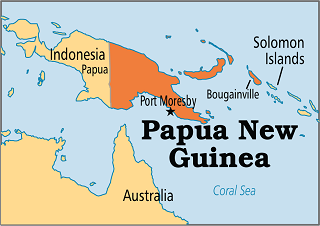The Eco-Transformation of Papua New Guinea

I’ve known Luimack Johnson for several years now, and he writes: Good day Mr. Craig Shields, how are you? Per your offer, please review my plans for eco-development here on Papua New Guinea.
Craig Shields: Good evening, Luimack. Wow. This is really fascinating. Let me start with a few questions:
What are nubia and potsdamhafen?
Are the two mines that you control operational? If so, please send me the recent financial reporting.
Are there any other streams of cash that can be generated immediately?
What’s the approximate equity that you have in the plantations (or any other real estate holdings)?
How much liquidity do you and the other investors you represent have available?
Is it OK for me to publish this conversation? It might interest a potential investor.
Luimack: Good day Mr. Craig Shields. Thank you for your reply.
Nubia and Potsdamhafen Plantations are mainly coconut and cocoa Plantations that are adjacent to each other. Total area of both plantations is 620 Ha combined.
The two proposed mines are not developed yet. The Plantations and where the potential mine sites are in different locations about 300 kilometres apart.
The best way to make streams of cash immediately is to have some seed capital of about US $500K – $1 million, and I go into our area (very remote) and surrounding areas and purchase several kilogrammes of gold from villagers and move the gold to Port Moresby (capital city) for smelting. Once that’s done and a certificate is issued of weight and purity then it is sold to one of the outlets in Port Moresby for the best price or the gold is exported to an overseas market.
When transactions are completed then the investor is paid his principle money and his interest, and the process can be repeated again and again.
Of course there would be some legal agreement in place to protect both Parties. Each trip would take 1.5 – 2 months.
We are a Start-Up landowner company “Hanza Bay Plantations Limited” and own 100% of our traditional, customary land. The plantations have mature coconuts and cocoa and have estimated value of US $10 million and $15 million respectfully. We may consider mortgaging the property to secure any loans.
It is OK with me to publish this conversation to attract a potential investor.
Thank you Mr. Craig Shields. Kind regards, Luimack
Craig: Well, again, this is a fabulously interesting project. I’m not sure I’ve ever seen anything that proposed a wider scope of environmentally beneficial businesses.
It may be tough to attract investors at the project’s infancy; I believe you will have to mortgage at least one of the properties, as required to bootstrap the mining operation and assemble a team of seasoned professionals who have track records of success in these various disciplines. Once there is positive cash flow, which means reduced risk, and a credible team in place, it will be much easier to attract private capital.
In the meanwhile, if we have any investors out there with big dreams and an interest in working with a wonderful individual, I hope they’ll let me know, so I can put them in contact with you.

Craig,
Like you I wish Luimack Johnson all the best in his quest to advance the business activity of his nation.
Sadly, New Guinea has a reputation as the land of “craft and corruption” . A very dangerous society where public and personal safety is on the same level as the worst African/South American failed states.
It’s a sad state of affairs, making investment very difficult.
Some years ago, I was in Papua-New Guinea and witnessed a curious little morality play.
In the deep rain forest, near the coast a cave was been discovered where an entire little world had evolved dependent on Bats which flew our every night to forage, returning during the day to rest.
The Bats brought back pollen, seeds etc, which contributed to the debris of the floor of the cave, as well as droppings and of course dead bats. From this debris and the tiny daylight provided by the cave’s small opening, was added water and some vegetation blown in. Even insects and a small rodent which must have fallen in as a breeding pair, been trapped but found enough sustenance to evolved and survive.
In the caves small lake several species of small fish and water creatures had evolved into unique life forms.
This little miniature Eco-system had existed for millennia (or longer) until discovered by western scientists.
Unfortunately, the local villagers got the idea the Bats were valuable and in a effort to cash in, stretched a net across the cave entrance, trapping the bats and causing and permanent exodus by the survivors.
I often think of the inhabitants of that small world, wondering uncomprehendingly as to the reasons for the cataclysmic event that had caused their destruction.